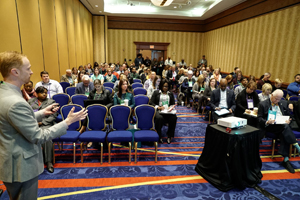
When dealing with student bodies, it’s important to remember each individual is their own person, with different desires and values propelling them forward in the realm of higher education, advised Brian Galloway, student retention and admissions officer at Villanova University, in his 2018 AACRAO SEM session.
Because of this it’s impossible to extinguish transfer rates at institutions. However, it is possible for institutions to heighten their retention rates--all by asking the right questions.
To improve retention rates, Galloway suggested the following ten questions institutions should ask:
1. What does 1% at your institution look like?
How many more students retained will increase your retention by 1%? This puts your student body (and retention rates) in perspective for you. For Villanova’s student population at 1,677 students, this placed them at retaining 17 more students to increase overall retention by 1%. Also question what retaining more students does for your institution. In general, it’s better for presidents, provosts, rankings, and financial aid to be retaining more students. On the flip side, it strains housing, dining, class space/faculty, and support services to be retaining more students. Make an analysis of each outcome and proceed accordingly.
2. When do your students leave you?
On average, most students left Villanova after the second term. Students who left earlier on generally had more financial mobility and left for better ranked schools. Later leavers struggled academically. The solution? Pour more funds into an academic support network to best support these later leavers who didn’t necessarily want to leave but felt that they had no choice.
3. What does your academic support landscape look like?
Benchmark your academic support network against other colleges and move forward accordingly.
4. Have you assessed your special population programs?
Have a student population control group and compare it to senior student exit survey. Learn from the feedback and data and make corrections for the next semester.
5. How do you interact with students who demonstrate no “at-risk” behavior?
Villanova monitored transcript requests--a general indication students were planning to leave. An officer would then arrange an appointment with the student and discuss their desires and what they could do to help them.
6. Do you have an effective exit interview?
Why are the students leaving? Learn from the interview and plan for the future. Common reasons were social dissatisfaction, financial aid, weak academics. One problem Villanova had with student retention was the feeling of no diversity on campus, with students coining the term “Vanillanova.” The university then began planning heritage months and events to better encourage diversity and community building across campus.
7. How do your retention and graduation rates differ across academic colleges?
For STEM related majors, more students had taken AP level courses in high school, better preparing them for college level coursework. This negatively affected students of color at a disproportionate level compared to their white peers. The ability to level the playing field for each student regardless of their background is one the institution should actively target and work on.
Galloway suggested examining not only who is leaving the institution, but also movement across colleges (for example, students who move from the Arts college to the Science college) and graduation rates by starting major, and analyzing the reasons for the movement.
8. How warm is your campus?
Encourage community building, diversity, and a sense of a friendly campus. Make your students feel involved and cared for.
9. Is your office positioned to deliver nuanced help to at-risk students?
If you can identify at-risk students, what can you do to actually help them? Make sure you have a strong academic support network before reaching out. Be able to properly identify and target issues, along with providing solutions.
10. Do you have a retention council?
If your institution is serious about retention, have a retention council that is devoted towards student retention. Don’t place the issue on a backburner as it will never be resolved.
"An important take-away from the presentation is that improvement in retention and graduation rates is likely the results of many small efforts," noted attendee
Dr. Jeffrey von Munkwitz-Smith. "All-in-all, it was an excellent, thought-provoking presentation!"
Find the session handouts here.